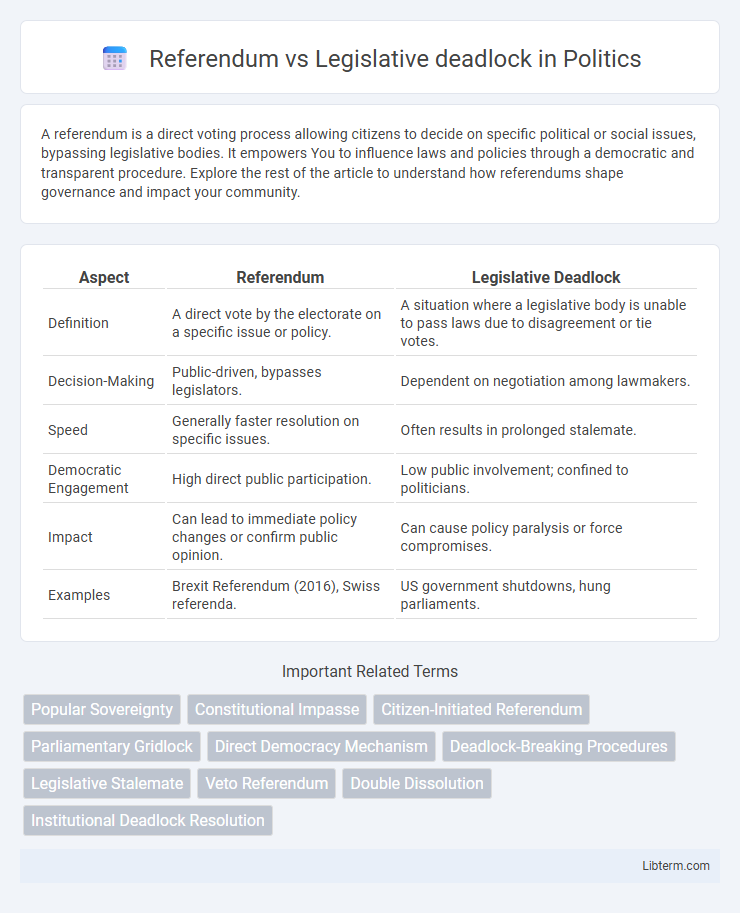A referendum is a direct voting process allowing citizens to decide on specific political or social issues, bypassing legislative bodies. It empowers You to influence laws and policies through a democratic and transparent procedure. Explore the rest of the article to understand how referendums shape governance and impact your community.
Table of Comparison
| Aspect | Referendum | Legislative Deadlock |
|---|---|---|
| Definition | A direct vote by the electorate on a specific issue or policy. | A situation where a legislative body is unable to pass laws due to disagreement or tie votes. |
| Decision-Making | Public-driven, bypasses legislators. | Dependent on negotiation among lawmakers. |
| Speed | Generally faster resolution on specific issues. | Often results in prolonged stalemate. |
| Democratic Engagement | High direct public participation. | Low public involvement; confined to politicians. |
| Impact | Can lead to immediate policy changes or confirm public opinion. | Can cause policy paralysis or force compromises. |
| Examples | Brexit Referendum (2016), Swiss referenda. | US government shutdowns, hung parliaments. |
Understanding Referendums: Definition and Purpose
Referendums are direct democratic tools that allow citizens to vote on specific legislation or policy proposals, bypassing the traditional legislative process. They serve to resolve legislative deadlock by providing a clear mandate from the electorate, ensuring decisions reflect public will rather than political stalemate. This mechanism enhances democratic legitimacy and can expedite decision-making on contentious issues.
What is Legislative Deadlock?
Legislative deadlock occurs when opposing political parties or factions in a legislative body are unable to reach agreement on key issues, resulting in a standstill that prevents the passage of laws. This impasse often leads to governmental inefficiency, delays in policy implementation, and increased public frustration. In contrast to referendums, which allow direct citizen voting on specific issues, legislative deadlock reflects internal political gridlock within representative institutions.
Historical Context: Referendums vs Legislative Impasses
Referendums have historically served as direct democratic tools allowing citizens to resolve political issues when legislative bodies face deadlock, exemplified by Switzerland's frequent use of referendums to bypass parliamentary stalemates. Legislative deadlocks often arise from partisan divisions or institutional structures, such as the U.S. Senate filibuster, which can delay or halt lawmaking and prompt reliance on referendums for decisive outcomes. The contrast highlights the evolution of democratic processes where referendums provide a mechanism for public resolution amid persistent legislative impasses.
Key Differences Between Referendums and Legislative Deadlocks
Referendums enable direct public voting on specific laws or policies, allowing citizens to bypass representatives, whereas legislative deadlocks occur when elected officials fail to reach agreement, stalling decision-making. Referendums often result in clear, binding outcomes based on majority votes, while legislative deadlocks create gridlock, preventing the passage of legislation. The main difference lies in direct democracy through referendums versus representative decision-making mechanisms affected by partisan or procedural impasses in legislatures.
Causes of Legislative Deadlock
Legislative deadlock often arises from deeply polarized political parties or factions that impede consensus on policy decisions, resulting in stalled legislative processes. Conflicting interests between executive and legislative branches exacerbate gridlocks, particularly when checks and balances restrict unilateral action. Procedural rules, such as filibusters or supermajority requirements, further contribute to deadlock by raising barriers to passing legislation despite pressing governmental needs.
The Role of Referendums in Breaking Deadlocks
Referendums serve as direct democracy tools that resolve legislative deadlocks by allowing citizens to vote on contentious issues when elected representatives reach an impasse. This mechanism bypasses prolonged political stalemates in legislatures, providing a definitive, public mandate that can guide subsequent policymaking. Referendums enhance governmental legitimacy by reflecting popular will, effectively breaking gridlocks caused by partisan conflicts or institutional barriers.
Advantages and Disadvantages of Referendums
Referendums enable direct public participation in decision-making, enhancing democratic legitimacy and ensuring policies reflect the popular will, which can resolve legislative deadlock by bypassing slow or gridlocked parliaments. However, referendums may oversimplify complex issues, risk majority tyranny over minority rights, and be influenced by misinformation or emotional campaigns, potentially undermining informed decision-making. The direct nature of referendums contrasts with legislative processes that allow for debate, amendment, and compromise but can become stalled due to political polarization or institutional conflicts.
Impacts of Legislative Stalemate on Governance
Legislative deadlock hampers effective governance by delaying critical policy decisions and budget approvals, leading to government shutdowns or reduced public services. This stalemate erodes public trust and fosters political polarization, decreasing legislative productivity and citizen satisfaction. In contrast, referendums can bypass gridlocks by allowing direct voter decisions on key issues, potentially accelerating policy implementation and enhancing democratic engagement.
Case Studies: Resolving Deadlock through Referendums
Referendums serve as effective tools to overcome legislative deadlock by directly involving the electorate in decision-making processes, as seen in the 2016 Brexit referendum where public vote resolved parliamentary stalemate on EU membership. Similarly, the 2014 Scottish independence referendum provided a democratic resolution to political impasse, allowing citizens to determine the region's future governance. These case studies demonstrate that referendums can bypass legislative gridlock by empowering voters to settle contentious policy issues.
Future Outlook: Balancing Direct Democracy and Parliamentary Processes
The future outlook of referendum versus legislative deadlock involves striking a balance between direct democracy mechanisms and parliamentary decision-making to ensure effective governance. Incorporating referendums can empower citizens by enabling direct input on critical issues, potentially breaking legislative impasses that stall policy progress. However, careful design of referendum procedures is essential to complement parliamentary processes without undermining representative democracy or causing policy instability.
Referendum Infographic

 libterm.com
libterm.com